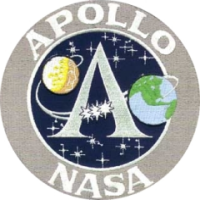While the
available
online documentation is helpful and interesting, it is only a tiny
fraction of the documentation produced by the Apollo project. So
where is the rest of it?
I don't actually know the full answer to the question posed above---for
example, I don't currently know where many versions of the AGC source
code is stored. (Probably somewhere in the musty depths of Draper
Labs, never to be viewed again by mortals such as you or I.) But
I do know
where
a lot of documentation
is hiding.
The Wonders of N.A.R.A.
A lot of U.S. government documentation is not thrown away, but rather
is eventually retired to the
National
Archives and Records Administration (NARA). NARA maintains a
number of centers about the country, in which the records for the
geographical region associated with that center are stored. I
happen to live in Dallas, Texas, and since the Johnson Space Center
(JSC)---formerly the Manned Spacecraft Center (MSC)---is in the
vicinity of Houston, my first hope was that perhaps JSC
may have preserved some of the Apollo documentation. Well,
perhaps JSC has preserved such documentation---the extensive historical
archive search engine on their website certain implies that they
have!---but I was advised by the NASA history office that JSC's
documentation would long since have been sent to the NARA center for
the Southwest Region, which happens to be in Forth Worth, Texas, a mere
hour from Dallas. So I went over and looked.
It's difficult to believe the quantity of Apollo-related documentation
to be found at NARA's
Southwest Region center. The NARA archivists measure it by
shelf-foot rather than by document or by number of pages. I can
only assume that the amount of Apollo-related documentation lurking at
the other NARA centers is equally staggering.
Indiana Jones
Normally, when you visit NARA, you're expected to know what you're
looking for, so that the archivists can pull it from the stacks for
you. In other words, researchers such as myself are not allowed
in the stacks. I was lucky enough not to know exactly how to
describe what
I was looking for---namely, the AGC source code---but to know what it
would look like when I saw it, so I had the privilege of being escorted
into the stacks briefly for a visual survey of the MIT-related Apollo
records. It was much like the final scene in
Raiders of the Lost Ark, where the
ark of the covenant is wheeled into a vast warehouse where it can never
be found again. The main difference, though, is that NARA stacks
are more packed and not so open and airy as the
Raiders warehouse. The NARA
personnel (at least in the Southwest region) are, however, very
friendly, and very eager to help you find what you are looking
for. I've never had any experience with governmental entities as
pleasant as my experiences at NARA.
"Record Group 255"
A summary of the records transferred to NARA-Southwest from the Johnson
Space Center---so-called Record Group 255---can be seen (in Microsoft
Word format) by
clicking here.
If you
examine this summary, you'll find that the records for the Apollo
Spacecraft Program Office---and these aren't all of the Apollo-related
records, by any means---total an astounding 730
feet of shelf space. (For
some reason, the document linked above seems to double estimates of
shelf-space, so you have to halve most of the estimates to get an
accurate idea.)
Record Group 255 is subdivided into groupings identified by "entry
numbers". Apollo Spacecraft Program Office (ASPO) data begin at
entry number E.205T5 ("general subject files") and end with entry
number E.216 ("microfilm aperture cards of drawings"), but
Apollo-related information may be found in many other groupings as
well. Each grouping is itself subdivided into a sequence of
boxes; most of the boxes are 4" thick (i.e., capable of holding a
4"-thick stack of documents), though some boxes (like those holding
"drawings" or microfilm) are much bigger.
Since M.I.T.'s Instrumentation Lab developed the AGC software, it seems
logical to look for AGC data within the records designated E.209G,
"Massachusetts Institute of Technology Documents"---fortunately, only
20 feet of shelf space. The records within E.209G were never
fully indexed when transferred from JSC to NARA, so I have prepared my
own index, which you can
view
by clicking here. The records for E.209G are stored in 59
four-inch-thick boxes, so to find any particular document, you need to
know which box
it is in, so that that box can be pulled from the stack.
I have scanned various documents from E.209G which are important to the
Virtual Apollo project, but which aren't available elsewhere online, or
which are only available in a corrupted form elsewhere online.
You can find these scans on my
Links page.
Finding Aids
My goal in sifting through NARA's JSC holdings was, of course, to
locate versions of
Colossus
and
Luminary (and
Sundisk and
Skylark) software not previously
available on the web. In this, I was ultimately
unsuccessful. However, as I expanded my search beyond merely the
MIT technical documentation described above, I found it expedient to
create some finding aids that would let me come back (perhaps a few
months or years) later and retrieve documents from NARA that are
interesting but not immediately urgent. (The
red links were formerly not
available at this site because of disk-space limitations, but should be
available now.)
- An inventory, created by
NARA-Southwest of all of the groupings
(by "entry number"), in Microsoft Word format.
- E.156L (Flight/Mission Operations Directorate, "Flight Operations
Handbooks"). I've scanned a JSC-created list of
the documents,
found in box 1.
- E.156N (Flight/Mission Operations Directorate, "Flight Operations
Apollo Mission Documents"). I've scanned
a JSC-created list of
the documents, found in box 1.
- E.157G (Flight/Mission Operations Directorate, "Mission Planning
and Analysis Internal Notes"). I've scanned the title pages of
all documents in the four-inch-thick boxes #11 through #56 (1968-1970),
in TIFF format.
- E.158 (Flight /Mission Operations Directorate, "System Division
Reference Files"). I've scanned
the title pages of all documents,
in TIFF format.
- E.209 (ASPO, "Apollo Working Papers"). I've scanned the
title pages of all documents, in TIFF format.
- E.209A (ASPO, "NASA General Papers"). I've scanned the
title pages of all documents, in TIFF format.
- E.209B (ASPO, "MSC Internal Notes"). I've scanned the title
pages of all documents, in TIFF format.
- E.209D (ASPO, "Contractor Technical Documents"). I've scanned the
title pages of documents, in some boxes---specifically, some of the AC
Sparkplug boxes---in TIFF format. See also
"miscellaneous AETI", below.
- E.209G (ASPO, "MIT Technical Documents"). I've manually indexed all 59
four-inch-thick boxes.
See also "miscellaneous AETI", below.
- E.209H (ASPO, "TRW Technical Documents"). I've scanned the
title pages of all documents, in TIFF format. (Actually, boxes
#112-115 and #118-123 included a lot of very short documents like memos
that I didn't bother to include.) See also
"miscellaneous AETI", below.
- E.209L (ASPO, "Grumman Technical Documents"). See
"miscellaneous AETI", below.
- Miscellaneous AETI: An MSC/JSC-created index of "a majority
of the pertinent design and development reports published by the Apollo
spacecraft contractors" also exists. This Apollo Engineering and
Technology Index (AETI) has several flaws: It stops in mid-1968
(and hence can't conceivably include much of the software-related stuff
in which we're interested); it lists documents not actually found
in the NARA-Southwest archives; there is no direct relationship to
NARA-Southwest groupings and box numbers. But it's very useful
nevertheless. The AETI exists in 5 parts:
As you will perceive, these miserable little finding aids barely
scratch the surface. Perhaps 10-20% of documents are
covered. Drawings have not been covered at all.
Where's the AGC Software?
I would really like to have the software for each manned Apollo
mission, including the Apollo-Skylab and Apollo-Soyuz missions.
Failing that, I'd like to have the software for Apollo 17---which,
obviously, would be the "best" version of the software ever used on a
lunar mission. Failing that, I'd like to have matching LM and CM
software for any lunar mission. Failing that, I'd like to have a
later version of
Colossus than
I have now. Failing that ... any version other than the versions
presently available online!
But I can't find any of it. If you'd like to help me find the
software, here are some random thoughts on the subject:
- Being able to unambiguously identify the AGC software, by part
number, would be a valuable contribution. I'm not aware of MIT
having any designations other than phrases like "Colossus 1A revision
249" or "Luminary 1C revision 131".
- NASA also seemingly assigned part numbers to the AGC software (or
to the software listings),
but I have no authoritative listing of such part numbers.
See the table below.
- I believe also that TRW sometimes assigned part numbers to the
AGC software, for the purpose of providing references against which
software valildation (partly a TRW task) could be performed. (The
TRW number refers to the symbolic listing of the program, rather than
to the program itself.) For my purposes, a TRW program listing is
as good as an MIT or NASA/MSC program listing.
- It also wouldn't be unreasonable for Raytheon (the manufacturer
of the core-ropes) to have assigned part numbers. I've seen no
Raytheon docs yet, so this is mere speculation.
| Mission |
MIT
Designation (?)
|
NASA or
MSC Part Number (?)
|
TRW Part
Number (?)
|
AS-202
|
Corona revision ???
|
|
3420.5-5,
28 March 1966
|
Apollo 1
|
Sunspot revision ???
|
|
|
Apollo 4
|
Solarium revision 055
|
1021108-021
|
|
Apollo 5
|
Sunburst revsion ???
|
|
|
Apollo 6
|
Solarium revision ???
|
|
|
Apollo 7
|
Sundisk revision ???
|
|
|
Apollo 8
|
Colossus 1 revision 237
|
2021111-031
|
|
Apollo 9
|
Colossus
1A revision 249
|
2021111-041
|
|
Apollo 9
|
Sundance revision 306
|
|
|
Apollo 10
|
Comanche (Colossus 2) revision 045
|
|
3420.5-27
Rev. 2, 20 November
1969
|
Apollo 10
|
Luminary 1 revision 069
|
|
|
Apollo 11
|
Comanche (Colossus 2A) revision 055
|
2021113-051
|
|
Apollo 11
|
Luminary 1A revision 099
|
2021112-061
|
|
Apollo 12
|
Comanche (Colossus 2B) revision ???
|
|
|
Apollo 12
|
Luminary 1B revision 116
|
|
|
Apollo 13
|
Comanche (Colossus 2C) revision 067
|
|
|
Apollo 13
|
Luminary
1C revision 131
|
2021112-091
|
|
Apollo 14
|
Comanche (Colossus 2D) revision 072
|
|
|
Apollo 14
|
Luminary 1D revision 178
|
|
|
Apollo 15-17
|
Artemis (Colossus
3) revision 072
|
2021114-011
|
|
Apollo 15-17
|
Luminary 1E revision 210
|
|
|
Skylab
|
Skylark revision 48(?)
|
|
|
ASTP
|
Skylark revision ???
|
|
|
- I am reasonably certain that there are no paper harcopies of the
AGC software at NARA-Southwest, but I have no clue at all as to whether
software listings may be included among the microfilmed "drawings" in
groupings E.215 and E.216.


